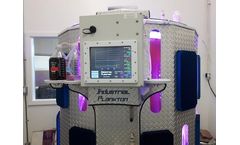Refine by
Oyster Articles & Analysis: Older
19 articles found
Fish Farming Ponds: Constructing large fish farming ponds for raising various species of fish, such as tilapia, salmon, catfish, or shrimp. Shellfish Farms: Establishing oyster or mussel farms using suitable infrastructure like floating cages or racks in coastal areas. ...
Why use Rhodomonas for feeding oysters and other aquatic animals? Particle Size Rhodomonas algae have medium cell sizes, which makes them an ideal food source for oyster larvae. The cells are well-suited for the small filtering apparatus of young oysters, allowing them to efficiently capture and consume the algae. Nutritional Content Rhodomonas ...
Project Overview Oysters play an important role in maintaining balance in aquatic environments. ...
The Alabama Gulf Coast is well known for supplying quality seafood to consumers around the world. Because of its massive levels of water usage, the seafood processing industry brings with it a need to use water efficiently throughout its ...
Project Details PRODUCT(S): miniDOT® Logger APPLICATION: Aquaculture, Salt Water PARAMETER: Dissolved Oxygen, Temperature LOCATION: Kauai, Hawaii ORGANIZATION: Kauai Sea Farm RECOGNITION: Dave Anderson, Production Manager Case Study Description Raising Clams and Oysters Nestled in the caldera of a dormant volcano in Kauai, Hawaii, Kauai Sea Farm uses this natural ...
Genetics is defined as that branch of the biological sciences devoted to the study of inherited variation. Genetics investigations deal with the “why” and “how” of this variation, examining both the origin of inherited variability and the resulting outward expression of characters due to this variability. The applications of genetics in today’s society are far ...
High Risk Groups and Raw Fish and Shellfish Molluscan shellfish, including clams, oysters, and mussels, are filter feeders and can accumulate marine bacteria and viruses. ...
Here’s this woman, the industrial architect, and she has this grand vision of bringing back the harbor by bringing back oysters. So here I am, in this murky, disgusting water. We find one oyster. ...
ByEnsia
Mangrove roots and trunks provide a structure that species such as oysters can grow on. Their roots also trap fine particles, creating soft soils ideal for molluscs and crustaceans to burrow in. ...
Called “reef streets,” these pocket ecosystems provide habitat for oysters, lobsters, juvenile fish and other organisms. Unlike traditional levees, which often barricade the beach. ...
ByEnsia
Green‐colored oysters are now found in Chinese estuaries due to their accumulation of metals (especially copper). ...
This Case Study tested adult Eastern Oysters (Crassostrea virginica Gmelin) from locations which supported comparable short‐term survival rates by evaluating growth and tissue health/disease. Biomarkers indicated oyster tissues at one site were normal, the female:male sex ratio was 50:50, and female oysters were in spawning condition. Conversely, ...
In this study, we took advantages of the supply of naturally contaminated oysters and investigated how the subcellular metal distribution and the metal burden in prey affected the transfer of metals to a marine fish, the grunt Terapon jarbua. The oysters Crassostrea hongkongensis with different contaminated histories were collected and separated into three ...
In the present study, the authors investigated the effect of chronic exposure to zinc in spats of the Pacific oyster (Crassostrea gigas), from metamorphosis up to 10 weeks. The authors investigated integrated biological endpoints that would account for the apparent general health of the animals as well as molecular markers showing more subtle effects that could potentially go ...
Flow cytometry allowed the rapid and quantitative analysis of oyster and lobster cell subpopulations and their functions (phagocytosis, peroxide production, natural killer cell-like activity and apoptosis). We demonstrated experimentally that water salinity, water temperature and infection with P. marinus modulated oyster defence mechanisms, and lobsters relative ...
Potential culture of approximately 70 commercially endemic species not only constitutes an economic option, but also favours their conservation.Keywords: shellfish culture, culture technologies, Chile, environmental effects, aquaculture, diversification, scallops, oysters, mussels, conservation, disease, fouling, borers, red tide, environmental ...
P. marinus was never evidenced in the oyster tissues examined. Statistical results from principal components analysis show that metallothioneins are positively correlated with copper and chromium, neutral red and oedema with chlordanes, pentachloroanisol, drins, polychlorobiphenyls and total pesticides, total hydrocarbons and polycyclic aromatic hydrocarbons, whereas ...
The number of individuals of the most abundant organisms (barnacles, oysters and mussels) settling per panel was determined each month, for each substrate type, panel orientation and height above creek bottom. The barnacle, Fistulobalanus citerosum has a peak settlement period during the wet season whereas both peaks in the numbers of settlers of the oyster ...
The anthropogenous influence began to have an effect already in the 20–30th. In this period, all oyster-banks were lost and the mussel-silt and mellina-silt communities have begun to degrade and were not found during almost seventy years in the Bay. ...












